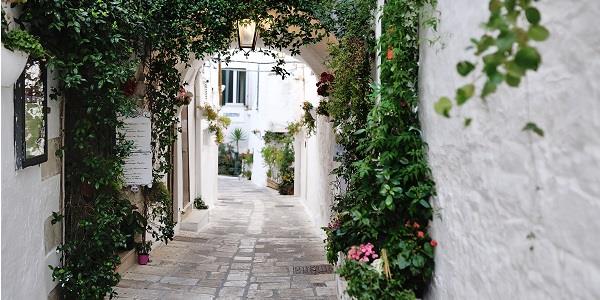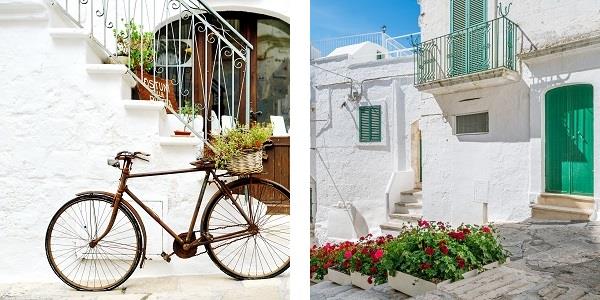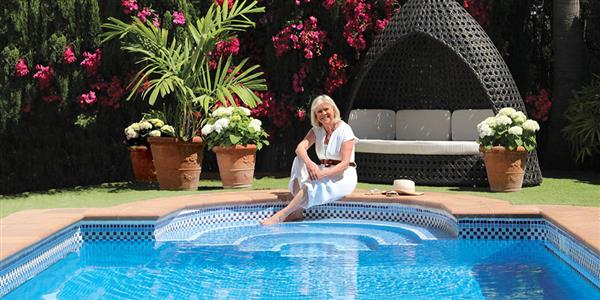
40 minutes from Coreggia, you’ll find the enchanting city of Ostuni. One of the most stunning cities in southern Italy, this historic town is famous for its dazzling whitewashed houses and beautiful architecture. Despite its clear Italian roots, Ostuni has a distinctly Greek feel – perhaps not surprising, considering it lies barely 45 miles from Greece over the Adriatic and Straight of Otranto.
Set across a series of levels, joined by staircases and narrow alleyways, this delightful town is a real step into the past. Hints of its long history can be seen around every corner, from the arches and city walls to the impressive cathedral. In fact, there is evidence of Neanderthals living in this area over 40,000 years ago!
The real beginnings of Ostuni can be traced back to the 1st and 2nd centuries, when the Romans constructed a town called Astu-neon (“new city”) – it was from here that the name Ostuni originated. After the fall of the Roman Empire the city was occupied by the Ostrogoths and Longobards in turn, before the Normans arrived in the 11th Century. From here the city expanded and developed, and was held by various groups until Garibaldi united Italy in 1860.

Today Ostuni is a beautiful and lively town that’s very popular with tourists during the summer months. The city was built without a plan, and it shows in the sprawling maze of bright white streets Set on top of a hill, the houses were built more or less on top of each other, supported by archways to make up for the lack of foundations. All these twists and turns make wandering the labyrinth of narrow paths an experience in itself, especially at sunset, when everything takes on a rose tint. It’s easy to spend a day exploring all the corners of this city, being rewarded by the occasional glimpse of the bright blue sea in the distance.
Despite their beauty, the bright white buildings of Ostuni actually have a more ominous backstory – a plague tore through the town during the 17th Century, and the infected houses were painted white using a mixture of limestone dust and water. It was noticed that the areas around the white houses had less illness. This was seen as miracle, although most likely it was the antibacterial effect of the calcium carbonate! Whatever the reason, all the houses were painted white from then on. Today the streets are decorated with brightly painted wooden doors and overflowing flowerboxes, drawing in tourists from all over the world. To keep their beauty, the local government encourages the locals to repaint every couple of years, and even pays for half of the work.


The main street in Ostuni is lined with shops and boutiques, selling everything from local olive oil to Salentino sandals. It’s a charming place to spend a few hours shopping and picking up souvenirs for loved ones. However, if you’re looking for something a little less typical, make sure to step away from the beaten path and down some of the many side streets. Here you’ll find all manner of traditional gifts and talented craftsmen.
For a taste of Ostuni’s rich history, the cathedral is also a must-see. Located at the highest point of the city, this 15th Century cathedral was built in the late Gothic style. This makes is very different from most of the local churches, which are built in the Romanesque or Baroque styles. The cathedral was declared a national monument in 1902 and it’s easy to see why, with its graceful, intricate design and delicate frescos. The highlight of the building is surely its magnificent rose window; with three concentric circles and 24 elegant beams, it’s a beautiful piece of architecture.

The Obelisk of Sant'Oronzo is yet another highlight of the city. Built in 1771, it has a pyramidal shape and a statue of Saint Oronzo at the top. Next to the obelisk is another small church, this one built in 1637. The main feature of this small but charming church is the portal, which was originally part of a medieval church in Piazza del Moro.
Another historic site that’s worth a visit is the city’s defensive walls. The construction of the walls dates back to the city’s oldest inhabitants, including Messapians, the Byzantines, the Normans, the Angevines and the Aragonese. After an earthquake in 1456, the Aragonese reinforced the towers and walls and expanded the defensive boundary on the southern side. Only two of the four original gates into the city can still be seen, but the impressive structures give a real glimpse into the dramatic history of this charming city.

If you feel the need to fill up with some delicious Italian cuisine during your visit, then there’s plenty of places to stop for a bite. For a taste of classic Puglian food, Osteria del tempo perso is a great choice. Located at the top of the old town, this smart restaurant is hidden away inside a cave! They’re famous for their fresh, classic food, and the unique setting makes dining here a real experience. Booking in advance is always required, especially in summer – make sure to ask for the main restaurant if you want to be seated inside the cave!
If you’d rather enjoy the fresh air, we’d recommend La Taverna Della Gelosia. Set in a courtyard garden of one of the iconic white houses, it's a perfect place for sitting beneath the trees with a cool drink and tasty meal. The menu is all in Italian and changes frequently, but again is made up exclusively of fresh, traditional food. The seafood, in particular, is highly recommended!
If you’re looking for a trip out which can be easily completed in a day and combines history, tradition and beauty, then Ostuni is the perfect choice. Less than an hour’s drive from our Coreggia property, it’s a fantastic insight into this beautiful part of Italy.

Continue your Italian adventure with a stay in one of Coreggia’s Trulli – traditional round Apulian dwellings built using a unique drywall technique, featuring pyramidal, domed or conical roofs. With comfortable, modern interiors which nonetheless still keep that traditional feel, they’re the perfect accommodation for a holiday in rural Italy.
To learn more about our Coreggia property, as well as our many other holiday locations, simply get in touch with our team. Alternatively, make sure to request a brochure.

